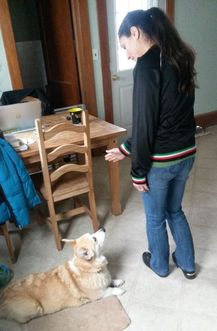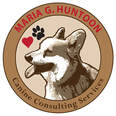Small Slices - What Do These Really Look Like?
Has this ever happened to you?… You try teaching your dog something new, and just when it seems like he’s getting it, all of a sudden it seems like he’s forgotten all he’s learned! Could this be because your dog is forgetful? Not likely. The most common reason I see for this backslide is what I call the “small slice conundrum” – meaning that when teaching your dog his new skill, you may not have broken the lesson into small enough slices and have tried progressing the skill faster than he was really able to learn.
Dogs have a harder time generalizing, understanding concepts and “thinking outside the box” than humans do. So when we try teaching our dogs at our pace, sometimes the communication barrier between human and dog creates a teaching breakdown. We jump too far too fast, have expectations that are too high, extinguish reinforcement too quickly and work in larger chunks that don’t allow our dogs to succeed.
The good news is, this conundrum is totally fixable and we can help your dog succeed in learning his new skills! We just have to break lessons down into the right size of small slices so your dog can learn. So how do you do this? By:
Dogs have a harder time generalizing, understanding concepts and “thinking outside the box” than humans do. So when we try teaching our dogs at our pace, sometimes the communication barrier between human and dog creates a teaching breakdown. We jump too far too fast, have expectations that are too high, extinguish reinforcement too quickly and work in larger chunks that don’t allow our dogs to succeed.
The good news is, this conundrum is totally fixable and we can help your dog succeed in learning his new skills! We just have to break lessons down into the right size of small slices so your dog can learn. So how do you do this? By:
|
Consistently reinforcing the right behavior every time while building a foundation and gradually working towards intermittent reinforcement (i.e. rewarding with treats and praise every time, then every other time, then every few times, etc.) Dogs – and even most of us humans – tend to handle things better when there is a gradual change rather than a “cold turkey” change.
Using a higher rate of reinforcement (through more frequent praise and treats) when the situation is very difficult for your dog and a lower rate of reinforcement (less frequent praise and treats) as he becomes successful, or in less difficult situations. Helping him understand the difference between a good job (some praise, pets and maybe a treat) and a fantastic job (a puppy party with tons of praise, several food rewards, and so much fun it’s like hitting the jackpot!) Rather than having an expectation of the final result (i.e. a 1-minute sit), start with very low expectations and gradually grow your expectation upon successful attempts (i.e. start with the expectation that your dog can sit for 3 seconds, then after some practice your expectation can grow to 5 seconds, then to 10 seconds, etc) Noticing the first step in the right direction if needed and making it worthwhile for your dog (this is usually referred to as approximating behavior). After he starts getting it, then you can start cleaning up what behavior you are reinforcing to be most precise (i.e. your pup is learning “down” and he is pawing at your hand holding the food lure as he lays down. In the beginning, don’t focus on the fact that he was pawing at your hand; focus on the fact that he laid down when you asked - praise and reward him. Then after some successful attempts, you can praise him when he gets into the down position but not release the food reward right away - only once he stops pawing. After a few more successful attempts, you will not release the praise or food treat if he paws, only if he does not.) Only once your dog can perform each skill successfully on an individual basis should you begin chaining behaviors together and asking him to do more than one thing for a single reward, as well as expanding expectations and delaying reinforcement (i.e. your pup is across the room and you want him to come lay on the floor next to you. As he’s learning, you should ask him to “come” - praise and reward, then ask him to “down” - praise and reward. Once he performs both skills successfully on a consistent basis, you can ask for “come” and then “down” and reward him once after he has performed both.) Treating new situations as new learning opportunities and taking a few steps back to the beginning until your dog shows he can perform his skills the same way in this new situation too (i.e. your dog can successfully perform a stay in one room at home while you are in another room 20 feet away, but now a repairman comes in to do some work on your kitchen and your dog needs to investigate who you are talking to - this unfamiliar voice he does not know! Start by asking your dog to stay at the doorway to the kitchen with you close by to support him with praise and treats as you talk to the repairman. Then start increasing distance by 1 to 2 feet at a time as your dog becomes successful.) |
Real Life Example:
Objective: Get your dog to "stay" on his dog bed as you answer the door
Note: Each step is beginning with your dog laying on his dog bed, approximately 10 steps from the door. You can verbally praise your dog throughout the process, especially if he is struggling, to provide him with extra reinforcement as needed (not only at the end of the step). It is best to teach these small slices in a controlled situation that you have set up specifically to practice (i.e. with a friend or family member you have enlisted to help, not the unexpected and highly stimulating UPS delivery guy). Once your dog has been successful in these controlled practice sessions, you can begin adding in the unpredictability/excitement factor to progress your dog’s skills.
Objective: Get your dog to "stay" on his dog bed as you answer the door
Note: Each step is beginning with your dog laying on his dog bed, approximately 10 steps from the door. You can verbally praise your dog throughout the process, especially if he is struggling, to provide him with extra reinforcement as needed (not only at the end of the step). It is best to teach these small slices in a controlled situation that you have set up specifically to practice (i.e. with a friend or family member you have enlisted to help, not the unexpected and highly stimulating UPS delivery guy). Once your dog has been successful in these controlled practice sessions, you can begin adding in the unpredictability/excitement factor to progress your dog’s skills.
|
Step 3:
Step 4:
|
|
Step 5:
Step 6:
Step 7:
|
|
Step 8:
Step 9:
|
Step 10:
- Give dog a clear hand and verbal “stay” command
- Walk confidently to door, open door one foot and greet person for 3 seconds (person stays outside), shut door
- Return to dog, praise and reward
Step 11:
- Give dog a clear hand and verbal “stay” command
- Walk confidently to door, open door all the way and greet person for 3 seconds (person stays outside), shut door
- Return to dog, praise and reward
Step 12:
- Give dog a clear hand and verbal “stay” command
- Walk confidently to door, open door all the way and greet person for 10 seconds (person stays outside), shut door
- Return to dog, praise and reward
Step 13:
- Give dog a clear hand and verbal “stay” command
- Remain near dog to provide reinforcement through praise and treats, call to person to enter
- Provide plenty of praise and treats to dog as person enters. Dog must remain on dog bed
Step 14:
- Give dog a clear hand and verbal “stay” command
- Remain near dog to provide reinforcement through praise and treats, call to person to enter
- Provide plenty of praise and treats to dog as person enters. Person stays in doorway. If dog is calm and focused on you, release dog to greet person
This is only an example – you may find that some dogs can handle slightly larger slices, or that for some dogs these slices are still too big (i.e. you may have to start with just leaning away from your dog instead of actually taking any steps away). As your dog becomes successful with these steps, you can begin adding more distraction (like the ringing of a doorbell) or longer duration (like greeting your guest for 20 seconds), or change from using hand and verbal commands to using only verbal or only hand commands. But remember - to help your dog be successful, only change one thing (either distraction or duration, but not both) at a time!
|
Many of us find that our dogs are very smart and pick up on lessons quickly if we just meet them where they’re at in terms of learning. Breaking lessons into small slices allows our dogs to meet success and build confidence, and also makes us feel proud of our star pupils – making learning fun for all involved! |
For more help on building your dog's skills and working through problem areas, contact Maria at (845) 549-0896 or [email protected]. Together we can discuss your goals, break lessons into the slices that your particular dog needs, and help you both meet success!
Written by Maria Huntoon, Maria G. Huntoon Canine Consulting Services











